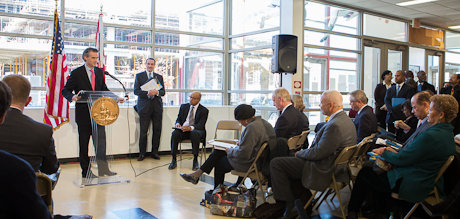Several George Washington M.B.A. students have played an integral role in helping Mayor Vincent Gray deliver a five-year economic plan that is expected to create 100,000 new jobs and rake in $1 billion in new revenue for the District.
“From the time I arrived in Washington, I have been keenly interested in figuring out how our business school could help serve the D.C. community and work with the city,” School of Business Dean Doug Guthrie said. “Our spirit of engagement and desire to bring about positive change was the impetus to embed our school, faculty and students more deeply in our community and address the economic issues facing society.”
The “Economic Development Strategy for the District of Columbia” plan, released on Nov. 14, focuses on six visions: creating a business-friendly economy; growing the largest technology center on the East Coast; being the nation’s “destination of choice;” ending retail leakage, or when District residents spend money outside the District; developing a global medical center; and becoming the top North American destination for foreign investors, businesses and tourists. More than 50 initiatives are attached to the visions.
Students’ contributions were varied, from coauthoring sections of the report to conducting interviews and statistical analyses around different industries.
Daniel Roth, a second-year M.B.A. student, coauthored a section about technology with teammates from Georgetown University. He said technology, along with real estate, are “two exciting industries for the District.” Real estate because it’s strong within D.C. when compared with other District industries and it’s strong nationally when compared with real estate in other major U.S. markets—and technology because of the possibilities for the District.
“What I found personally intriguing is the mayor’s level of commitment to growing the technology presence in the District,” Mr. Roth said.
Meanwhile, Omar Hamwi, a second-year M.B.A. student, worked on a team to analyze and develop the professional services sector and also looked at how the District can be more business-friendly with regard to its taxes and incentives. He said the use of interviews in researching for the report is an important aspect.
“Those in the public and private sectors were given an ear to voice their opinions and vision for how the city could grow and how lives can be improved all over the city,” Mr. Hamwi said. “I believe this is a rare opportunity in which everyone was engaged for the common good.”
Fatih Saglik, a second-year M.B.A. student who researched the retail sector and made recommendations on how to make the District more retail-friendly, said the experience went a long way in his professional development, and he really enjoyed working in a team.
“The most rewarding part of the job for me is to get to meet lots of intelligent, experienced people. It is like a shortcut to get familiar with lots of ideas,” Mr. Saglik said.
Stephan Kallus, a second-year M.B.A. student who worked on the higher education and health care section, agreed.
“The greatest aspect of the fellowship for me was gaining access to industry experts and thought leaders in health care,” he said. “It was great to hear their opinions on the rising costs in health care and potential solutions that could help curb costs while also improving the overall quality of care to patients throughout the health care system.”
In all, working on the plan showed the contributions students can bring in a real-world situation.
“Above all else the experience offered me an opportunity to see the great work that such intelligent and capable students at GW and the other D.C. universities can put together,” Mr. Roth said. “It was exciting to see that our hard work and analysis led to a road map for the mayor to follow to help propel the District forward over the next five years.”


